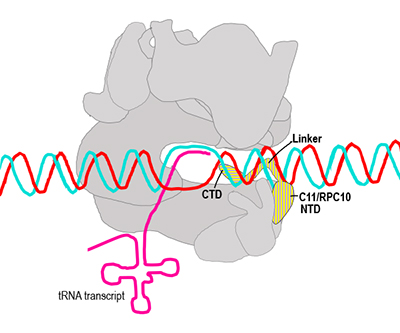
RNA polymerase III (gray) transcribing tRNA. C11/RPC10 is highlighted in yellow.
Credit: Maraia Lab, NICHD
In all eukaryotic cells, nuclear RNA polymerase III (Pol III) is responsible for transcribing genes that encode transfer RNAs (tRNAs). In humans and other organisms, cytoplasmic Pol III (cyto-Pol III) plays a critical role in antiviral immunity. People with specific mutations in Pol III subunits experience severe immunodeficiency to specific viruses. Cyto-Pol III senses specific viral DNAs and synthesizes small RNAs that act as signaling molecules to stimulate antiviral immune responses. However, the mechanism of cyto-Pol III transcription initiation on viral DNAs differs from that of nuclear Pol III and remains unknown.
Scientists, including the Maraia Lab, study Pol III to better understand how it works and how its subunits uniquely contribute to the health and function of a cell. Recent studies have advanced understanding of the role of the small but crucial Pol III subunit C11 (called RPC10 in humans).
Pol III synthesizes the highly abundant tRNAs by a unique, high-efficiency transcription process known as reinitiation-recycling. This depends on C11/RPC10 and its mobility within the 17-subunit Pol III. C11/RPC10 monitors the Pol III active site and can modify its catalytic activity.
C11/RPC10 is composed of an N-terminal domain (NTD) and a C-terminal domain (CTD) connected by a flexible linker. Biochemical evidence suggests distinct functions for the NTD and CTD and indicates that the NTD-linker is sufficient for Pol III reinitiation-recycling activity. The NTD anchors at the Pol III periphery. The linker-CTD can adopt multiple conformations, allowing it to swing in and out of the active site, coordinated with movements of the Pol III DNA-binding clamp, during the initiation and termination phases of the transcription cycle. These movements may be relevant to viral DNA loading by cyto-Pol III during immune signaling.
 BACK TO TOP
BACK TO TOP